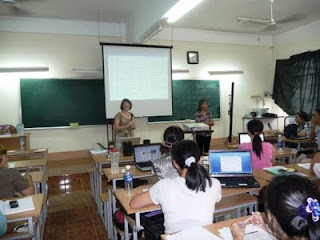 While travelling in Viet Nam and Hong Kong I have been made very aware of the need to think about 3 categories of pronunciation:
While travelling in Viet Nam and Hong Kong I have been made very aware of the need to think about 3 categories of pronunciation: 1. "Correct" pronunciation: this includes the official pronunciation of a language
2. Variants in pronunciation: this includes dialectal variants that are produced by adults and children, particularly from a region/cultural group
3. Errors in pronunciation: this includes productions by children with speech sound disorder, who are unable to produce a sound in the appropriate context.
Speech pathologists work with children and adults in the third group. They typically do not work with people in the second group.
For example, in Viet Nam there is an official pronunciation that is closely related to the Ha Noi dialect. This pronunciation is encouraged by the government, and within the schools (see story below from the Viet Nam News). However, within Viet Nam, many people use different pronunciations of consonants, vowels and tones (e.g., n/l, d/nh, d/z, tone 3/tone 4) that are typical variants within their province/region. It is important to differentiate between these variants in pronunciation and errors that are made by children and require speech therapy.
Pronounced improvement (from Viet Nam News, Monday 9th May, 2011)
"The Ha Noi Department of Education and Training said it had helped to improve pronunciation and spelling of Vietnamese in primary schools in the capital with its new teaching programme. Nguyen Tri Dung, deputy head of the Primary Education Department, said the authority had been running a pronunciation training programme since 2009 for both teachers and students in primary schools in thirteen suburban districts with some success. He said teachers and children for example often had trouble distinguishing between the sounds of "l" and "n".
"This is a long-term programme because the habit [of mispronouncing words] began long ago and cannot be easily eliminated in a day or two," Dung said... "Mispronunciation leads to misspelling, and misspelling will negatively affect the students' academic performance and cause problems in communication," Hang said.
'To reduce confusion between letters and promote accurate pronunciation, teachers have been asked to correct students' spelling and diction in non-language classes.
Pronunciation training also forms part of extra-curricular activities. Meanwhile, teachers are encouraged to meet regularly to boost their language skills.
Dung added that the programme was designed to promote standard Vietnamese not just at school but in society as a whole because students would interact with other members of the community.
Vu Thi Du, the principal of Quang Trung School in Phu Xuyen District, said the programme was implemented two years ago and had achieved positive results. Pronunciation and spelling training is now given in all classes... According to a survey conducted in thirteen suburban districts by the Department of Education and Training, the number of primary school teachers with poor diction had fallen markedly and now stood at 9 per cent as opposed to 12 per cent at the end of the 2010-11 school year. Meanwhile, the proportion of students mispronouncing words has fallen from 22 per cent to 18 per cent during the same period. The ministry surveyed about 11,000 teachers and 204,000 students in thirteen suburban districts for the study. — VNS"























